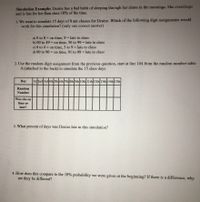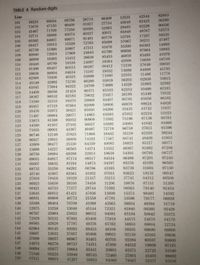
MATLAB: An Introduction with Applications
6th Edition
ISBN: 9781119256830
Author: Amos Gilat
Publisher: John Wiley & Sons Inc
expand_more
expand_more
format_list_bulleted
Concept explainers
Question
Please

Transcribed Image Text:**Simulation Example:**
Denise has a bad habit of sleeping through her alarm in the mornings. She oversleeps and is late for her 8 am class 10% of the time.
1. **We want to simulate 15 days of 8 am classes for Denise. Which of the following digit assignments would work for this simulation? (only one correct answer)**
a) 0 to 8 = on time, 9 = late to class
b) 00 to 49 = on time, 50 to 99 = late to class
c) 0 to 4 = on time, 5 to 9 = late to class
d) 00 to 90 = on time, 91 to 99 = late to class
2. **Use the random digit assignment from the previous question, start at line 104 from the random number table A (attached to the back) to simulate the 15 class days.**
| Day | 1st | 2nd | 3rd | 4th | 5th | 6th | 7th | 8th | 9th | 10th | 11th | 12th | 13th | 14th | 15th |
|-------------|-----|-----|-----|-----|-----|-----|-----|-----|-----|------|------|------|------|------|------|
| Random Number | | | | | | | | | | | | | | | |
| Was she on time or late? | | | | | | | | | | | | | | | |
3. **What percent of days was Denise late in this simulation?**
4. **How does this compare to the 10% probability we were given at the beginning? If there is a difference, why are they different?**
**Explanation of Visuals:**
- A table is provided to record the random numbers and determine whether Denise was on time or late for each of the 15 days. Each column represents one day of class.
- Participants in the exercise will fill out the table based on the chosen digit assignment method and random numbers from the supplementary material.

Transcribed Image Text:**Table A: Random Digits**
This table consists of rows and columns filled with random digits. It's commonly used in statistics and research to simulate random sampling or for other purposes where random numbers are needed.
**Description:**
- **Line Numbers:** Each row begins with a line number ranging from 101 to 150.
- **Random Digits:** Each line contains five groups of five-digit numbers. The numbers are randomly arranged without any apparent pattern, reflecting the typical output of a random digit table.
**Example Entries:**
- **Line 101:** 19223, 95034, 05756, 28713, 96409
- **Line 102:** 12531, 42544, 82853
- **Line 103:** 73676, 47150, 99400, 01927, 27754
The table serves as a tool to extract unbiased random samples for experimental and other purposes.
Expert Solution
This question has been solved!
Explore an expertly crafted, step-by-step solution for a thorough understanding of key concepts.
This is a popular solution
Trending nowThis is a popular solution!
Step by stepSolved in 3 steps

Knowledge Booster
Learn more about
Need a deep-dive on the concept behind this application? Look no further. Learn more about this topic, statistics and related others by exploring similar questions and additional content below.Recommended textbooks for you
 MATLAB: An Introduction with ApplicationsStatisticsISBN:9781119256830Author:Amos GilatPublisher:John Wiley & Sons Inc
MATLAB: An Introduction with ApplicationsStatisticsISBN:9781119256830Author:Amos GilatPublisher:John Wiley & Sons Inc Probability and Statistics for Engineering and th...StatisticsISBN:9781305251809Author:Jay L. DevorePublisher:Cengage Learning
Probability and Statistics for Engineering and th...StatisticsISBN:9781305251809Author:Jay L. DevorePublisher:Cengage Learning Statistics for The Behavioral Sciences (MindTap C...StatisticsISBN:9781305504912Author:Frederick J Gravetter, Larry B. WallnauPublisher:Cengage Learning
Statistics for The Behavioral Sciences (MindTap C...StatisticsISBN:9781305504912Author:Frederick J Gravetter, Larry B. WallnauPublisher:Cengage Learning Elementary Statistics: Picturing the World (7th E...StatisticsISBN:9780134683416Author:Ron Larson, Betsy FarberPublisher:PEARSON
Elementary Statistics: Picturing the World (7th E...StatisticsISBN:9780134683416Author:Ron Larson, Betsy FarberPublisher:PEARSON The Basic Practice of StatisticsStatisticsISBN:9781319042578Author:David S. Moore, William I. Notz, Michael A. FlignerPublisher:W. H. Freeman
The Basic Practice of StatisticsStatisticsISBN:9781319042578Author:David S. Moore, William I. Notz, Michael A. FlignerPublisher:W. H. Freeman Introduction to the Practice of StatisticsStatisticsISBN:9781319013387Author:David S. Moore, George P. McCabe, Bruce A. CraigPublisher:W. H. Freeman
Introduction to the Practice of StatisticsStatisticsISBN:9781319013387Author:David S. Moore, George P. McCabe, Bruce A. CraigPublisher:W. H. Freeman

MATLAB: An Introduction with Applications
Statistics
ISBN:9781119256830
Author:Amos Gilat
Publisher:John Wiley & Sons Inc

Probability and Statistics for Engineering and th...
Statistics
ISBN:9781305251809
Author:Jay L. Devore
Publisher:Cengage Learning

Statistics for The Behavioral Sciences (MindTap C...
Statistics
ISBN:9781305504912
Author:Frederick J Gravetter, Larry B. Wallnau
Publisher:Cengage Learning

Elementary Statistics: Picturing the World (7th E...
Statistics
ISBN:9780134683416
Author:Ron Larson, Betsy Farber
Publisher:PEARSON

The Basic Practice of Statistics
Statistics
ISBN:9781319042578
Author:David S. Moore, William I. Notz, Michael A. Fligner
Publisher:W. H. Freeman

Introduction to the Practice of Statistics
Statistics
ISBN:9781319013387
Author:David S. Moore, George P. McCabe, Bruce A. Craig
Publisher:W. H. Freeman